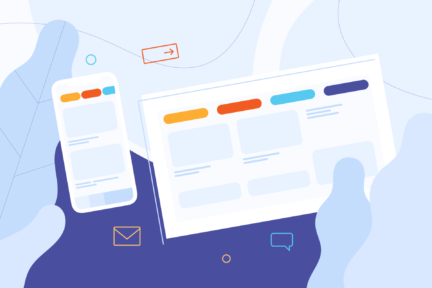We interact with countless websites and applications every day, but rarely think about how they’re built. Behind every sleek interface and smooth interaction is frontend development – the craft of creating the visual parts of digital products that users see and engage with.
What is frontend development?
To put it simply, frontend can be understood as client-side development, and it refers to the part of the application that is visible to users, i.e what they can actually see and interact with.
The role of a frontend developer isn’t limited only to implementing visual components, but also includes designing and taking care of interactive features such as navigation, buttons and anything else that affects the usability of the application. As such, the main goal for frontend development is to ensure the best possible user experience (UX), by creating a functional user interface (UI) and navigation over the web development.
What is the difference between frontend and backend development?
Backend development is often called the server-side of web application development and unlike frontend, backend is the part that the user doesn’t see. At the same time, it is indispensable for the app to work properly, as it is responsible for its business logic – it organises data, processes information and integrates with external services. Backend developers enable the application to communicate with databases and servers, as well as ensure security and the overall smooth performance of an application.
Want to learn more about the basics of backend development? Check out our beginner’s guide!
Core technologies for frontend development
You may have heard about languages such as JavaScript or Python, but frameworks tend to be a lesser-known topic, at least among those who are less tech-savvy. Let’s break down what you need to know.
Understanding languages vs. frameworks
Programming languages are the core tools developers use to write code. Frameworks, on the other hand, are pre-built structures and tools that make development faster and more consistent – think of them as specialized toolkits built on top of front end programming languages.
Developers choose languages and frameworks based on project requirements. The number of frontend development frameworks is vast, with each having specific strengths. While developers often have preferences, the best choice should always align with your business needs and project goals.
Essential frontend languages
HTML, CSS and JavaScript are three fundamental technologies that power front end development:
HTML – The markup language that creates the structure and content of web pages (text, images, forms).
CSS – Defines how everything looks, including colors, layouts, fonts, and spacing.
JavaScript – Adds interactivity and dynamic features, allowing applications to respond to user actions and communicate with backend systems.
JavaScript is often considered the primary frontend language because it extends beyond static elements, enabling the dynamic functionality users expect in modern applications. Though JavaScript has evolved significantly by 2025, these three technologies remain the foundation of frontend development.
Top frontend solutions for applications
Frameworks help developers build applications more efficiently. Here are the leading options:
React
You can bet on React when you’re building complex, dynamic applications. React ensures the app’s seamless performance and it can be easily used for both mobile and web application development. You can also feel safe when developing an app in React JS, as it has support of a vast community.
In 2025, React has grown even stronger with Server Components fully integrated into the core library. This allows parts of your React code to run on the server, reducing the JavaScript sent to the browser and improving performance. React’s virtual DOM approach continues to offer efficient updates, and the ecosystem around React (like Next.js) has made it easier than ever to build complete applications.
Best for: Complex, dynamic applications
Key strengths:
- Server Components that improve performance
- Virtual DOM for efficient updates
- Extensive ecosystem with solutions like Next.js
- Strong community support for both web and mobile development
Angular
This is one of the best choices if you’re planning to develop an app that’s small or medium in complexity. Angular offers high performance, component-based architecture suggesting a higher quality of code, as well as better tooling and higher scalability among other benefits. Yet, at the same time, it is also quite verbose and complex, requiring a steep learning curve.
By 2025, Angular has streamlined many of its complexities while maintaining its comprehensive approach. Angular 18 has introduced significant performance improvements and simplified development patterns, making it more accessible to newcomers while retaining its power for complex enterprise applications.
Best for: Enterprise applications with structured architecture
Key strengths:
- Comprehensive, all-in-one solution
- Component-based architecture
- Improved performance in Angular 18
- Powerful tooling and scalability options
Vue
Vue is one of the fastest of all available frontend frameworks, so it easily delivers precise UX in user interfaces and single-page applications. The goal of Vue’s creator was to combine the advantages of React and Angular, so this framework can be considered – in some way – to be “the best of both worlds”.
Vue has continued to evolve gracefully, and Vue 4 has solidified its position as a fantastic middle-ground option. The Composition API has become the standard approach for building Vue applications, offering better code organization and reuse. Vue remains especially appealing for companies looking for a framework that’s powerful but not overwhelming.
Best for: Balance between simplicity and power
Key strengths:
- Gentle learning curve with powerful capabilities
- Composition API for better code organization
- Excellent performance in user interfaces
- Middle-ground between React’s flexibility and Angular’s structure
Emerging Frameworks Worth Watching
Svelte – Compiles at build time rather than runtime, resulting in smaller, faster applications.
Qwik – Focuses on “resumable” applications with on-demand JavaScript loading for near-instant interactivity.
Astro – Specializes in content-focused websites, using components from various frameworks while shipping minimal JavaScript.
Frontend development trends to watch in 2025
Several key trends are shaping frontend development this year:
AI-enhanced development tools
AI-powered tools are revolutionizing how frontend code is written, with assistants that can generate entire components and suggest optimizations. These tools can now understand design intent, convert mockups to code, and even anticipate potential bugs before they happen.
Accessibility as a core requirement
Accessibility has become a fundamental requirement rather than an afterthought, with better tools to help developers create inclusive experiences. Modern frameworks now include built-in accessibility checks, and companies are increasingly recognizing that accessible design benefits all users.
Web-based AR/VR experiences
Web-based augmented and virtual reality experiences are becoming more common as browsers support immersive technologies and frameworks make them easier to implement. The WebXR API has matured, allowing front end developers to create engaging 3D experiences without requiring users to download specialized apps.
Edge computing for improved performance
Edge computing is bringing frontend code closer to users for better performance, with frameworks like Next.js, Remix, and Nuxt offering edge function support. This approach reduces latency and improves user experience, especially for global audiences.
How to choose the right frontend technology for your project?
There’s an endless amount of articles about frontend development that can aid you in picking the right technology, but in the end, it all comes down to the specifics of your project and the goals you’re trying to achieve.
When selecting a frontend technology in 2025, consider these practical factors:
- What’s the purpose of your application? Content-heavy sites might benefit from Astro or Next.js, while complex interactive applications might need React or Angular.
- What’s your team’s expertise? The best technology is often the one your developers already know well.
- How important is performance? If you’re targeting users with slower connections or devices, frameworks like Svelte or Qwik might offer advantages.
- What’s your timeline? Some frameworks offer faster development cycles than others.
- What’s your long-term maintenance plan? Larger, established frameworks tend to have better long-term support.
If you’re having trouble deciding on the best tech stack for building your application – contact us! Our experienced frontend developers will advise you on the best solution for your particular business needs.









